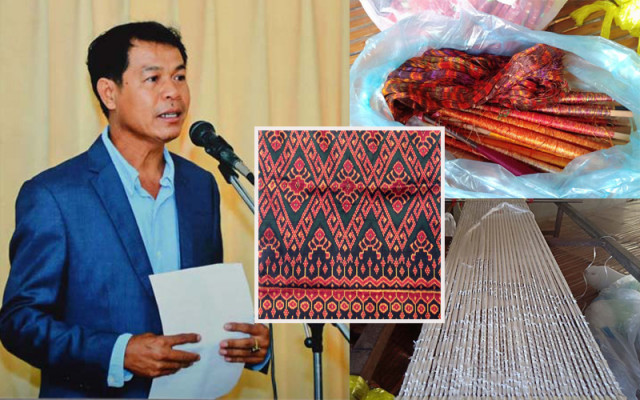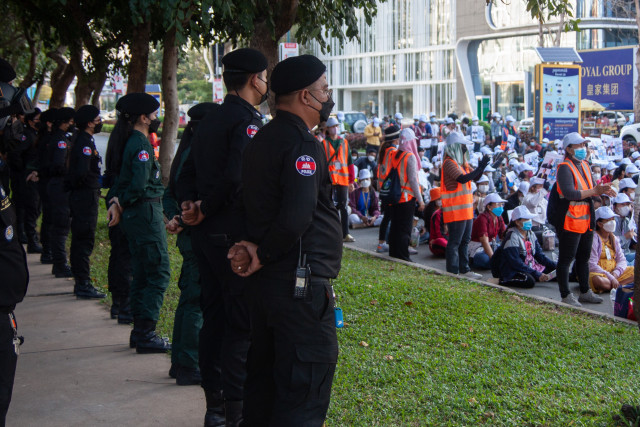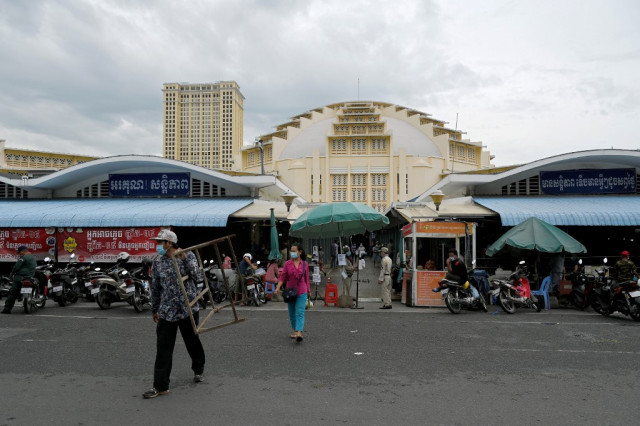Cambodian Silk’s Origins Traced Back to Prehistoric Era

- By Po Sakun
- and Teng Yalirozy
- September 22, 2021 7:31 PM
New discoveries in Kampong Chhnang Province have suggested Khmer silk is older than previously thought, but the silk weaving sector is in decline throughout Cambodia as modern methods prevail
PHNOM PENH--New evidence unearthed in Kampong Chhnang Province’s M’lou Prey archeological site suggests that Cambodian silk may be older than initially thought, dating back to long before Khmer culture was influenced by Indian culture.
The silk, experts have suggested, could have been worn by tribes living in mountainous regions even earlier than originally believed.
Chhim Sothy, director of the Arts and Handicrafts Department at the Ministry of Culture and Fine Arts, explained that through excavation, experts have found traces of silk or yarn on tools made of burnt clay and marble, which pre-date original findings significantly.
He said that the clothing of the ancient Khmer people evolved from wearing leaves to wearing loincloths. Then, they learned to weave silk.
However, silk during that period was plain and did not have many designs. After Kaundinya I—also known as Huntien and Preah Thong—the first king of Cambodia, ascended the throne, he made the Khmer silk more prosperous.
“In the early days, silk was less elaborate. It was like the clothes of the indigenous people living in today’s society, which are not very fancy,” Sothy explained. “In the days that Cambodia had the kings, the garments of silk were divided between royalty and ordinary people based on the colors and pattern of flowers. People started to raise silkworms and plant mulberry trees, which made Khmer silk more popular. India and China also came to Cambodia for the silk trade. The research on Khmer silk has been done since the French Era, and today, the research continues.”
Weaving a History of Silk
Sothy continued that there was a mutual cultural influence from Java as well as India to Cambodia during the 6th and 7th centuries. Then, Khmer silk adapted to more modern styles throughout the 7th and 8th centuries. Throughout the Angkorian era, the silk design was upgraded as shown on the fairy goddess carved on the Angkor Wat temple.
He said everything changed during the 9th and 10th centuries, when both the clothing and the jewelry become more sophisticated. By the 11th century, the costumes had become even more intricate as evidenced by the sculptures in Banteay Srei Temple, Pre Rup Temple, Mebon Temple, and many others in the Angkor Wat area.
The 12th century was the period of Angkor construction, so the design of all fields was even more unique, he said.
“The evolution of clothing from the Funan period to Angkorian period had been progressively better,” said Sothy. “Bayon style was in the 13th century and things were more unique, making women even more elegant due to the sophisticated design on each piece of clothing. After the 13th century, the nation significantly deteriorated due to warfare with foreign countries. By the Longvek period, there was also progress in Khmer costume, but there were also many wars with neighboring countries.”
He said that during the Oudong era, Khmer costumes were also upgraded because the Khmer Kings had many relations with the Siamese (Thailand). He said Khmer women started to wear shirts in the French Colonial Era.
Khmer people wove silk under their houses as there were weaving places in every part of the country. In the old days, Khmer women had to know how to weave handkerchiefs and scarfs for their family members, Sothy explained.
“The Khmer weaving industry flourished everywhere, just that sometimes it declined or rebounded because of war,” he said. “After being free from farming, people would weave. The improvement of the weaving industry depends on a nation that is secure and peaceful.”
Out with the Old
Sothy said he has noted that the current silk market in Cambodia is declining, with weavers giving up their jobs and go to work in factories. As more and more second-hand clothes are imported, most of the young Cambodian women tend to wear modern clothes without paying much attention to traditions.
“In Pchum Ben or Khmer New Year, some women wear jeans in the pagodas. The more distant the perception of people, the further distant the tradition,” Sothy said. “Weavers try so hard to weave each cloth, but it is now sold for a small amount of money. So, they go the work in the factories instead for $200 to $300 a month. People will leave tradition behind as they are trying to make a living. Now, only grandmothers weave a little at their house, and children go to work at other jobs.
“However, if the silk weaving market recovers, people may return to this industry. Most consumers are Cambodians living abroad, as in France and the United States. For local Cambodian consumers, they only buy Khmer silk if they admire the weavers’ efforts as well as the value of the Khmer silk.”
Sothy stressed that Cambodia lacks the cultivation of mulberries and silkworms rearing on a large scale that can harvest tons. He said Cambodian people also grow mulberries but only in small quantities. They plant mulberries mostly just for tourists.
However, if there were more financial support from the government, Sothy believes that the Khmer silk industry will flourish again.
Resurrecting Traditional Arts
Silk output, on the other hand, has fallen short of meeting demand thus far. Minister of Agriculture Veng Sakhon said this is because old ways are still being employed rather than innovative approaches being implemented.
“The development of mulberry production is still limited because mulberry cultivation, silkworm rearing, silk production, and traditional weaving have not changed,” he wrote on his Facebook page on July 16. “It can be said that people still lack [knowledge of] planting techniques and the selection of quality silkworms.”
To preserve and promote the silk sector in Cambodia, the Ministry of Agriculture, Forestry, and Fisheries in 2020 provided mulberry seeds to farmers and held training workshops on cultivation techniques, silkworm rearing and silk production processes to people in Banteay Meanchey, Kampong Chhnang, Kampot, Siem Reap and Takeo provinces.
However, Nim Marin, a former Khmer silk training expert at the National Silk Centre in Siem Reap Province, said she also was concerned about the decline of the silk sector in Cambodia, pointing out that mulberry farmers were becoming less aware of its benefits.
Since the mid-2010s, several programs were launched to encourage silk production.
In 2016, the government launched its National Silk Strategy, intending to expand the silk sector's role in the country's economy and respond to rising local and worldwide demand for silk goods.
In June 2019, Cambodia’s Khmer Silk Center was inaugurated in Phnom Penh as part of the country’s plans to develop silk farming and revitalize the sector.
Japan and the United Nations Development Programme in Cambodia have also been working as the government’s partners to help farmers expand quality-silk production.















